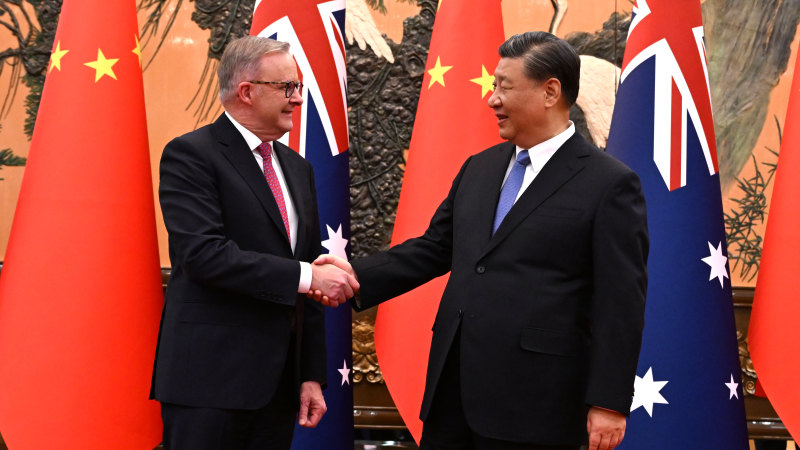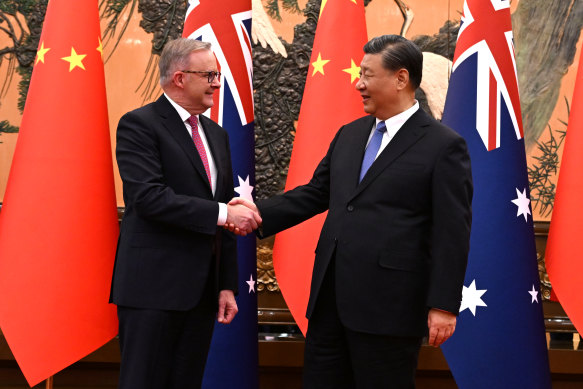Albanese’s high wire walk delivers promising result for Australia

Save articles for later
Add articles to your saved list and come back to them any time.
Anthony Albanese knew his meeting with Xi Jinping was a success when the Chinese president threw a quip about Kung Fu Panda into their talks on global security, trade and the economy.
The brief remark about a Hollywood comedy was a surprise detour in a discussion that sought to ease years of friction between Australia and its biggest trading partner.
Prime Minister Anthony Albanese said the leaders agreed they would take the relationship forward after a tumultuous four years of hostility.Credit: AAP
But it mattered because it signalled the relaxed tone of a formal meeting in Beijing that could have sunk into acrimony and lecture.
The outcome is certainly good news for Australians. The public display in the Great Hall of the People, where Xi greeted Albanese with a smile, is a way of telling everyone that Australia and China are getting along again.
That means Chinese companies can buy Australian exports with greater confidence and not be stung by a sudden trade ban. It means Chinese students or travellers can head to Australia with the knowledge that the diplomatic deep freeze is over.
While Xi will continue his pursuit of greater military power and economic might, which means new tensions are inevitable at some point, there is at least a sense that Australians can exhale after years of heightened anxiety.
The mention of Kung Fu Panda was not wholly benign. In the prime minister’s account, Xi spoke about Tasmanian devils as “cute” animals and Albanese disagreed by suggesting pandas were cuter. Xi tossed back a reference to the Hollywood panda that knew how to kick.
For anyone looking for hidden meaning, the two leaders were basically comparing national animals that looked friendly while being ready for a scrap.
In the main, however, the meeting was overwhelmingly positive. Xi made a point of calling Australia a comprehensive strategic partner – an idea from a decade ago rendered meaningless by trade curbs on Australian exports worth $22 billion a year.
Most of those sanctions have been removed. When the conversation turned to the remaining restrictions on wine, lobsters and beef, the strong impression on the Australian side was that the curbs would be lifted soon.
Albanese stated concerns about human rights and consular issues – that is, the detention of Australian writer Yang Hengjun. He told Xi of the Australian government’s support for the status quo in Taiwan.
Xi sought Australian support for China in joining the Trans Pacific Partnership trade pact, as expected. Albanese repeated, in public, his message that this required unanimous support from existing members such as Japan.
The diplomatic tussle over the trade pact is more symbolic than economic. China faces almost insurmountable objections on this front, especially a veto by Japan, but it wants to present itself as a fair trading partner and it seeks acceptance from countries around the Pacific.
China also seeks to heighten the contrast with the United States, which almost destroyed the trade pact by withdrawing its support. The rise of protectionism in the US gives Xi a way to present China as a champion of a fair multilateral trading system – one of his messages on Monday night.
In the Australian account, Xi did not raise concerns about the AUKUS alliance on nuclear-powered submarines. He did not need to because the Chinese objections are so public. Even so, this highlighted the way the meeting stayed on positive ground.
There were no complaints about decisions in Canberra to reject foreign investment, either.
What of the Chinese view of this meeting? The message to Albanese was to avoid narrow alliances that locked out others – a general warning that could apply to the Quad pact that joins Australia to the United States, India and Japan.
According to The China Daily, Xi told the Australian delegation to avoid actions that seek to build “small yards and high fences” rather than trading with China.
“Decoupling or de-risking are in essence all forms of protectionism that go against the laws of the market,” he said, according to the Chinese newspaper. But decoupling is now a concerted strategy in the US and Australia because it means reducing the reliance on China.
Xi, in other words, is arguing against the trend in the West to cut the dependency on China when his own trade restrictions have driven Australian exporters away.
This means there was a vindication for Australia in Monday’s meeting with one of the world’s most powerful leaders. Under Xi, China attempted years of economic coercion against Australia by imposing some of the biggest trade restrictions on any country. It did not work. Australia responded by seeking markets elsewhere and holding the line on foreign policy – for instance, on AUKUS, freedom of navigation in the South China Sea and foreign interference laws.
The Australian defensiveness over criticism from China has given way to a greater confidence that the nation can ride out similar threats in the future. There is a lesson to other countries in the region that they too could withstand a similar bout of economic coercion.
The meeting between the prime minister and the president could have gone badly for Australia if the two leaders had been unable to rise above the antagonisms of the past few years.
In the end, Xi and Albanese cemented a good relationship that lessens the sense of conflict between the two countries. If Xi expects something in return – other than, say, the membership of a trade pact – the price is yet to be posted in public.
The meeting ended with Albanese inviting Xi to Australia. The logical timeframe is late next year, a decade after Xi’s last visit.
Albanese began a delicate walk on a diplomatic tightrope as soon as he entered the Great Hall of the People. He reached the other side without slipping or falling. That is a good outcome for anyone who wants calmer relations with a rising superpower.
Cut through the noise of federal politics with news, views and expert analysis from Jacqueline Maley. Subscribers can sign up to our weekly Inside Politics newsletter here.
Most Viewed in Politics
From our partners
Source: Read Full Article
